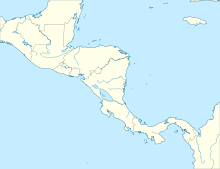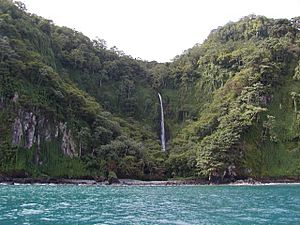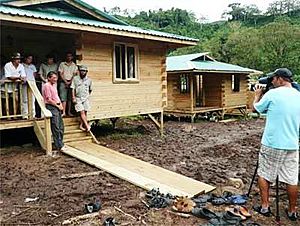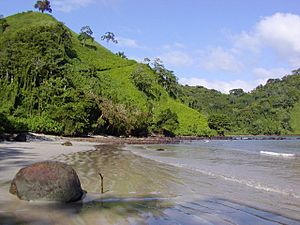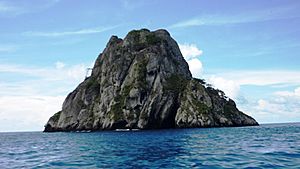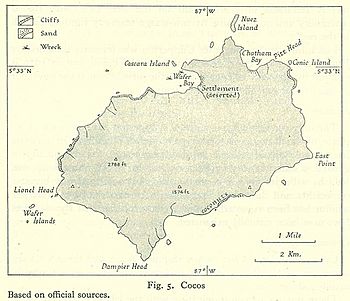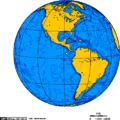Cocos Island facts for kids
Quick facts for kids Cocos Island National Park |
|
|---|---|
|
IUCN Category II (National Park)
|
|
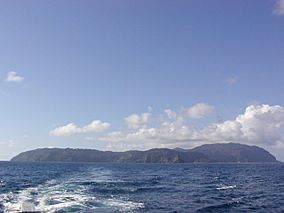
Cocos Island
|
|
| Location | Approximately 550 km (340 mi) off the shore of Costa Rica |
| Established | 1978 |
| UNESCO World Heritage Site | |
| Criteria | Natural: ix, x |
| Inscription | 1997 (21st Session) |
| Extensions | 2002 |
| Official name: Isla del Coco | |
| Designated: | 10 April 1998 |
| Reference #: | 940 |
|
Isla del Coco
|
|
|---|---|
|
District
|
|
| Country | |
| Province | Puntarenas |
| Canton | Puntarenas |
| Creation | 27 April 1970 |
| Area | |
| • Total | 23.52 km2 (9.08 sq mi) |
| Elevation | 0 m (0 ft) |
| Time zone | UTC−06:00 |
| Postal code |
60110
|
Cocos Island (called Isla del Coco in Spanish) is a special island in the Pacific Ocean. It belongs to Costa Rica and is about 550 kilometers (340 miles) southwest of the mainland. The island is shaped like a rectangle and covers about 23.85 square kilometers (9.2 square miles). It's the southernmost point of North America if you include islands far from the continent. It's also the only land you can see above water on the Cocos Plate, which is a huge piece of the Earth's crust.
Since 1978, all of Cocos Island has been a National Park in Costa Rica. Only park rangers live there permanently. The waters around Cocos Island are very deep and have strong currents. This makes it a favorite spot for scuba divers. They love seeing lots of hammerhead sharks, rays, dolphins, and other big ocean animals. The island's wet weather and ocean features make it unique. It's different from other islands in the eastern Pacific, like the Galápagos Islands. Because of its amazing nature, Cocos Island National Park became a UNESCO World Heritage Site in 1997. You can only get to the island by boat, which usually takes 36 to 48 hours.
Contents
Why Cocos Island is Special
Cocos Island became a Costa Rican National Park in 1978. Then, in 1997, UNESCO named it a World Heritage Site. This means it's a very important place for the whole world. In 2002, the protected area was made even bigger to include more ocean, covering 1,997 square kilometers (771 square miles). It's also listed as a Wetland of International Importance. In 2009, Cocos Island was even considered one of the New7Wonders of Nature. It came in second place in the islands group!
Many experts say Cocos Island is one of the top 10 scuba diving spots in the world. This is because of the huge variety of sea life in its waters. Popular dive sites include Bajo Alcyone, known for hammerhead sharks, and Manuelina Garden, which has beautiful corals. Divers often see large pelagic fish species, which are ocean fish that live near the surface. The biggest groups of hammerhead sharks in the world are often seen here. It's common to see dozens or even hundreds of these large animals on almost every dive. There are also many smaller, colorful fish living in one of the largest coral reefs in the southeastern Pacific. Famous ocean explorer Jacques Cousteau visited the island many times. In 1994, he called it "the most beautiful island in the world." These praises show how important it is to protect Cocos Island and its waters from illegal fishing and other dangers.
Only Costa Rican park rangers are allowed to live on Cocos Island. They have two camps, one at English Bay. Regular visitors can only go ashore with permission from the rangers. Tourists are not allowed to camp, stay overnight, or take any plants, animals, or rocks from the island. Sometimes, amateur radio groups are allowed to visit.
The island is also famous in pirate stories. People say that over 300 groups have searched for buried treasure there. Legends mention the treasure of Benito Bonito and the Treasure of Lima. A few small hidden treasures have been found. This makes many people believe the stories of huge pirate treasures are true. However, most searches have not found anything. The Costa Rican government strictly forbids treasure hunting now.
Hermandad Marine Reserve
In 2022, the President of Ecuador, Guillermo Lasso, announced a big expansion of the Galápagos Marine Reserve. This new area, called the Hermandad Marine Reserve, adds 23,000 square miles (60,000 square kilometers) to protect underwater mountains. It will connect with the protected waters around Cocos Island, creating an even larger safe zone for marine life.
Island's Shape and Features
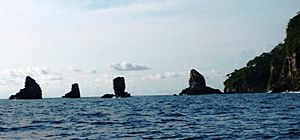
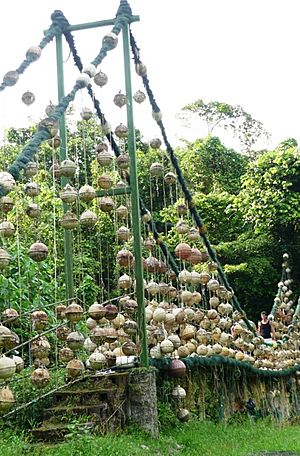
Cocos Island is an oceanic island. This means it formed from volcanic activity and shifting tectonic plates in the ocean. It's the only island above water on the Cocos Plate. The oldest rocks on the island are about 1.91 to 2.44 million years old. They are mostly made of basalt, which is rock formed from cooled lava.
The island is shaped roughly like a rectangle, about 8 kilometers (5 miles) long and 3 kilometers (2 miles) wide. Its edge is about 23.3 kilometers (14.5 miles) long. The land is very hilly and uneven. The highest point is Cerro Iglesias, which is about 575.5 meters (1,888 feet) tall. Even with all the mountains, there are some flatter areas in the middle of the island.
Cocos Island has many short rivers and streams. They carry the heavy rainfall into four bays. Three of these bays are on the north side: Wafer, Chatham, and Weston. The biggest rivers are the Genio and the Pittier, which flow into Wafer Bay. Much of the island is surrounded by steep cliffs, about 90 meters (300 feet) high. This makes it hard to get to the island except at a few beaches. Chatham Bay is the easiest place to land. The mountains and tropical weather create over 200 waterfalls all over the island! The soil on the island is very acidic. It would wash away easily in the heavy rain if it weren't for the thick forests covering the slopes.
Island Weather
The weather on Cocos Island is mostly controlled by something called the Intertropical Convergence Zone. This zone brings clouds and rain all year round. So, the climate is humid and tropical. The average temperature is about 26.6°C (79.9°F). The island gets a lot of rain, over 7,000 millimeters (276 inches) each year! It rains a lot all year, but a little less from January to March and again in late September and October. Many ocean currents, especially the North Equatorial Countercurrent, meet at the island. These currents also have a big effect on the weather. The island has a tropical rainforest climate.
| Climate data for Cocos island | |||||||||||||
|---|---|---|---|---|---|---|---|---|---|---|---|---|---|
| Month | Jan | Feb | Mar | Apr | May | Jun | Jul | Aug | Sep | Oct | Nov | Dec | Year |
| Mean daily maximum °C (°F) | 28.0 (82.4) |
29.0 (84.2) |
29.0 (84.2) |
29.0 (84.2) |
29.0 (84.2) |
28.0 (82.4) |
28.0 (82.4) |
28.0 (82.4) |
28.0 (82.4) |
27.0 (80.6) |
27.0 (80.6) |
28.0 (82.4) |
28.2 (82.7) |
| Daily mean °C (°F) | 26 (79) |
27.5 (81.5) |
27.5 (81.5) |
27.5 (81.5) |
27.0 (80.6) |
26.0 (78.8) |
26.0 (78.8) |
26.0 (78.8) |
26.0 (78.8) |
25.5 (77.9) |
25.5 (77.9) |
26 (79) |
26.4 (79.5) |
| Mean daily minimum °C (°F) | 24.0 (75.2) |
26.0 (78.8) |
26.0 (78.8) |
26.0 (78.8) |
25.0 (77.0) |
24.0 (75.2) |
24.0 (75.2) |
24.0 (75.2) |
24.0 (75.2) |
24.0 (75.2) |
24.0 (75.2) |
24.0 (75.2) |
24.6 (76.3) |
| Average precipitation mm (inches) | 585.4 (23.05) |
348.4 (13.72) |
235.1 (9.26) |
470.1 (18.51) |
857.5 (33.76) |
938.2 (36.94) |
806.2 (31.74) |
674.3 (26.55) |
753.9 (29.68) |
793.0 (31.22) |
625.9 (24.64) |
555.4 (21.87) |
7,643.4 (300.94) |
Island's Nature and Wildlife
Cocos Island is covered in thick tropical moist forests. It's the only island in the eastern Pacific with these kinds of rainforests and their special plants and animals. The cloud forests high up on the island are also unique in this part of the world. The island was never connected to a continent. This means its plants and animals traveled long distances from the Americas to get there. Because of this, many species found here live nowhere else on Earth.
Island Plants
The island has 235 known types of flowering plants, and 70 of them are found only on Cocos Island. There are also 74 types of ferns, 128 types of mosses, 90 types of fungi, and 41 types of slimemolds. Scientists believe there are many more species waiting to be discovered.
The island has three main plant areas. The coastal forests grow from the shore up to 50 meters (160 feet) high. Here, you'll find purple coral trees, coconut palms, and pond-apple trees. Underneath them are ferns, shrubs, grasses, and other small plants.
The inland forests grow from 50 to 500 meters (160 to 1,640 feet) high. The most common trees here are "palo de hierro" (ironwood), "avocado" (Ocotea insularis), and the special Cecropia pittieri. These trees are covered in epiphytic plants, which are plants that grow on other plants. These include orchids, ferns, bromeliads, and mosses. The undergrowth has sedges and various ferns, including tree ferns. The palm Euterpe precatoria is also common. Cloud forests are found at the highest parts of the island, above 500 meters (1,640 feet). Here, Melastoma plants are the most common.
The plants on Cocos Island have changed a lot since Europeans first explored it. Early visitors described large coconut groves. Some believe that ancient people might have cleared parts of the island to plant these coconuts. They might have used them as food and drink for long sea voyages. After these voyages stopped, the jungle grew back over the cleared land.
Island Animals
Land Animals
Cocos Island has over 400 known types of insects. About 65 of these (16%) are found only on this island. The most diverse groups are butterflies and moths, and ants. More than 50 other types of arthropods, like spiders, centipedes, and millipedes, have also been found.
There are two types of lizards on the island: the Cocos Island anole and the Pacific least gecko. Both of these lizards are unique to Cocos Island. No amphibians (like frogs or salamanders) live here.
Almost 90 types of birds have been seen on the island. The island and nearby rocks are home to huge groups of nesting seabirds that travel long distances. These include the brown booby, red-footed booby, great frigatebird, white tern, and brown noddy. Seven types of land birds live on the island. Three of them are found only on Cocos Island: the Cocos cuckoo, Cocos flycatcher, and Cocos finch. The island is recognized as an Important Bird Area (IBA) by BirdLife International.
Cocos Island does not have any native land mammals. However, humans have brought five types of mammals to the island: pigs, deer, goats, cats, and rats. These introduced animals can harm the local ecosystems. They eat native plants or hunt native animals. Because of this, efforts are made to control their numbers.
Ocean Animals
The rich coral reefs, volcanic tunnels, caves, and deep waters around Cocos Island are home to amazing marine life. There are over 30 types of coral, 60 types of crustaceans (like crabs), 600 types of molluscs (like snails and clams), and over 300 types of fish. This includes many yellowfin tuna, giant mantas, sailfish, and sharks. You can see whitetip reef sharks and scalloped hammerhead sharks. The biggest fish of all, the whale shark, also visits these waters.
Other large ocean animals found here include humpback whales, orcas (killer whales), pilot whales, bottlenose dolphins, and sea lions.
There are also several types of sea turtles: hawksbill turtles, green turtles, and olive ridley turtles.
Protecting the Island's Nature
Even though Cocos Island's natural areas are mostly untouched, they face growing problems from people. Illegal fishing of large marine animals in and around its protected waters is a big worry. The increasing demand for tuna, shark fin soup, and other seafood around the world is putting the island's delicate ecosystems at risk. The government of Costa Rica is working to protect the island's natural treasures and stop illegal fishing. However, it can be hard to patrol the waters effectively and enforce environmental laws.
Island History
Early Times
Before Europeans arrived, people likely did not live on Cocos Island. There hasn't been much archaeological study on islands like Cocos in the eastern Pacific. This is because these islands have very delicate environments that were untouched by humans for many years. Also, they are very far from islands where Polynesian people lived. Native Americans on the west coast of the continent were also not known to live on remote eastern Pacific islands. In 2008, archaeologists studied Cocos Island and other nearby islands. They found that the Galápagos Islands might have been visited by a Polynesian boat, but it's not clear what they found for Cocos Island.
Discovery and Old Maps
The Spanish explorer Juan de Cabezas (also known as Juan de Grado) discovered Cocos Island in 1526. An old map from 1542, called the "Henry II" map, is the first document to show the name "Isle de Coques." Other old maps from the 1600s also show "I. de Cocos" near the Equator.
Today, the island is covered in thick jungle. But old accounts from the 1600s say it used to have many coconut trees. Some people think that ancient farmers might have cleared land to plant these coconuts. This would have made the island a good stop for traders sailing off the coast of Panama.
Before the 1900s, scientists didn't know much about the plants and animals on islands like Cocos. In 1891, a science journal said, "we know nothing at all about the fauna and flora of the isolated Clipperton Island and Malpelo; we hardly know anything about Cocos Island, which seems to be in many respects quite different from the others, having a more tropical appearance."
How the Island was Governed
Cocos Island officially became part of Costa Rica in 1832. Whalers used to stop at Cocos Island regularly. But this stopped in the mid-1800s when kerosene became cheaper than whale oil for lighting.
In 1897, the Costa Rican government named a German adventurer, August Gissler, as the first Governor of Cocos Island. He tried to start a small settlement there, but it didn't last long.
On May 12, 1970, Cocos Island became the eleventh district of Puntarenas canton in the Puntarenas Province. As a district, its postal code is 60110.
The 33 people who live on the island are all Costa Rican park rangers. They were allowed to vote for the first time in Costa Rica's election in 2006. However, the rangers are not considered permanent residents. So, official population counts say the island has no permanent inhabitants.
Pirate Stories and Hidden Treasures
Cocos Island is famous for many tales of pirates and buried treasure. One story comes from a woman named Mary Welch. She claimed that Captain Bennett Graham, a pirate, buried 350 tons of gold (worth billions today) on the island in 1818. Mary had a map showing where the treasure was, but when she went back, the landmarks were gone.
Another pirate said to have buried treasure on the island was the Portuguese Benito Bonito. He was active around 1818. Even though Bonito was caught and executed, his treasure was never found.
Perhaps the most famous treasure story is about the fabled Treasure of Lima. In 1820, an army was approaching Lima, Peru. The city's leader, Viceroy José de la Serna, supposedly gave the city's treasure to a British trader, Captain William Thompson, to keep it safe. Instead, Thompson and his crew sailed to Cocos Island and allegedly buried the treasure there. Soon after, they were caught by a Spanish warship. All the crew were executed except Thompson and his first mate. They offered to show the Spaniards where the treasure was hidden to save their lives. But once they landed on Cocos, they escaped into the forest and were never caught again.
Hundreds of attempts to find treasure on the island have failed. Some early searches were based on stories from a man named Keating, who claimed to have been friends with Thompson. Keating supposedly found some gold and jewels on one trip. The German adventurer August Gissler lived on the island for many years, from 1889 to 1908, searching for treasure. He only found a few gold coins. British explorer Aeneas Mackintosh also went on a treasure hunt to Cocos in 1910, but he didn't find anything.
Cocos Island in Books
The book Desert Island suggests that Daniel Defoe used Cocos Island as a real-life model for the island in his famous novel, Robinson Crusoe. However, Defoe actually placed Crusoe's island off the coast of Venezuela in the Atlantic Ocean, not the Pacific.
The exciting stories of pirates and buried treasure linked to Cocos Island are believed to have inspired the famous novel Treasure Island, written by Robert Louis Stevenson.
Images for kids
See also
 In Spanish: Isla del Coco para niños
In Spanish: Isla del Coco para niños
- Island of the Sharks


